
Yamaha digital pianos are reliable and time-tested products. When I am asked to advise the brand of the digital piano – Yamaha usually takes one of the first places in my rating, no matter who you are – a student, a teacher, a hobbiest or a professional musician. This company has been doing acoustic pianos for more than a century. And Yamaha is a pioneer in digital piano technology. Its’ engineers spent a lot of time working on sampling of wide selection of timbres and voices, along with the numerous other features of the Yamaha digital keyboard instruments.
Many people ask me – what is the best Yamaha digital piano? Actually this is not a correct question. Similarly, one could ask – What is the best Mercedes car? After all, Mercedes produces a whole line of cars of various classes, cost, and comfort. Also in our case, the Yamaha digital keyboard instruments line is huge, and the best Yamaha digital piano will depend on your needs. Below, I will try to give my classification and tell a little about the different Yamaha electronic keyboards and digital pianos. I’ve spent a lot of time to classify and describe Yamaha products as I see it, I hope you will enjoy this article and learn something new. This article is not for professionals, but predominantly for home users, choosing Yamaha digital piano for practicing or just for having fun. Happy reading:)
Table of Contents
Best Yamaha Beginner Electronic Keyboard
Did you notice the word Keyboard in the title? That means that these beginner instruments which I want to describe in this section honestly are not digital pianos. Yes, they sound like piano and also have black and white keys, but there are also some differences. Check out electronic keyboard and digital piano comparison to find out what is different between them. If you are ready to go, here is my top of Yamaha electronic keyboards for beginners.
| PSR-E273 (YPT270) | PSR-E373 (YPT370) / PSR-EW310 | PSR-E473 / PSR-EW425 | EZ-300 | |
|---|---|---|---|---|
| Number of keys | 61 | 61 / 76 | 61 / 76 | 61 |
| Keyboard type | Touch Responsive | Touch Responsive | Touch Responsive | |
| Polyphony | 32 | 48 | 64 | 48 |
| Weight | 8.8 lbs | 10.1 lbs | 15.5 lbs/18.3 lbs | 10.6 lbs |
| Weight (kg) | 4 kg | 4.6 kg | 7 kg / 8.3 kg | 4.8 kg |
| Dimensions (WxHxD) | 940x104x317 mm | 945x118x369 mm / 1151x118x369 mm | 992x136x404 mm / 1200x136x404 mm | 945x118x369 mm |
| Voices | 384 | 622 | 820 | 622 |
| Featured Voices | - | 3 Live! Voices, 4 Sweet! Voices, 6 Cool! Voices, 11 Super Articulation Lite Voices | 3 Live! Voices, 9 Sweet! Voices, 6 Cool! Voices, 14 Super Articulation Lite Voices | 3 Live! Voices, 4 Sweet! Voices, 6 Cool! Voices, 11 Super Articulation Lite Voices |
| Effects | Reverb (9), Chorus (5), Master EQ (6), Ultra-Wide Stereo (3) | DSP (38), Reverb (12), Chorus (5), Master EQ (6), Harmony (26) | DSP1 (41), DSP2 (12), Reverb (12), Chorus (5), Master EQ (4) | DSP (38), Reverb (12), Chorus (5), Master EQ (6), Harmony (26) |
| Accompaniment styles | 143 | 205 | 290 | 205 |
| Preset Songs | 112 (Chord Study: 12) | 154 (Touch Tutor: 10, Chord Study: 12, Chord Progression: 30) | 30 | 200 (Touch Tutor: 10, Chord Study: 12, Chord Progression: 40) |
| Groove Creator | - | - | Yes | - |
| User Songs | 1 one-track | 5 two-tracks | 10 six-tracks | 5 two-tracks |
| Lesson mode | [1 LISTEN & LEARN], [2 TIMING], [3 WAITING] | KEYS TO SUCCESS, Lesson 1–3 (Listening, Timing, Waiting), Phrase Repeat, A-B Repeat, Chord Dictionary, Touch Tutor, Chord Study, Chord Progression | - | KEYS TO SUCCESS, Lesson 1–3 (Listening, Timing, Waiting), Phrase Repeat, A-B Repeat, Chord Dictionary, Touch Tutor, Chord Study, Chord Progression |
| Connections |
|
|
|
|
| Battery support | 6x AA-size | 6x AA-size | 6x AA-size / 6x D-size | 6x AA-size |
| Speakers | 2x2.5 W | 2x2.5 W | 2x6 W / 2x12 W | 2x2.5 W |
| Price | $ | $$ | $$$ | $$ |
| My Rating |   (4.1 / 5) (4.1 / 5) |   (4.4 / 5) (4.4 / 5) |   (4.6 / 5) (4.6 / 5) |   (4.5 / 5) (4.5 / 5) |
PSR-E273 (YPT-270)
This is the ideal entry-level Yamaha keyboard for starting out musicians. PSR-E273 (in some countires it is named YPT-270) is the cheapest Yamaha portable keyboard model, however it has everything you need to start playing. Although the model has not changed much from the previous one (PSR-E263), but there are still some minor improvements.
The keyboard of PSR-E273 was not changed: as the previous PSR-E263 it has 61 non-weighted organ-style keys which are not touch sensitive, which means no matter how hard or soft you push the key, it sounds always with the same volume. This is not very good, but is ok for the beginning. 32 polyphony voices (number of voices which can sound simultaneously) is also the minimum which you can play with.
It features a comprehensive library of 401 instrument voices of any musical genre. Main piano voice sounds rather good for this price, but it is still the same as in PSR-263, and even in more expensive PSR-E373.
PSR-E273 has 143 auto accompaniment styles (PSR-E263 had 110 styles) divided into categories on the panel. Styles provide real-time backing tracks based on the chords you play. Each style has Intro, Ending, and 2 variations – this is a standard for all PSR-E keyboards.
By the way I liked the improved user interface, now it looks more logical and user-friendly: colored category buttons are very convenient to use, and new Num Lock button locks keys for entering numbers if you prefer voice/style/song selection by its’ number.
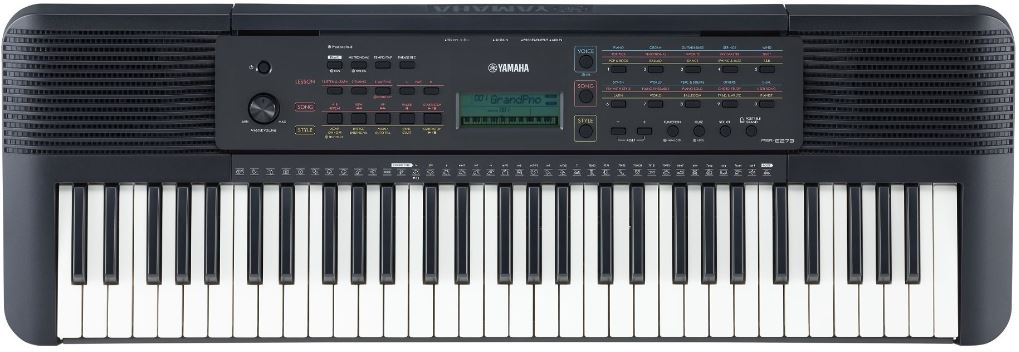
It has 112 preset songs which you can play along using the lesson mode, including special songs for chord study. The songbook with the songs is available for download on Yamaha website: https://usa.yamaha.com/products/musical_instruments/keyboards/portable_keyboards/psr-e263/downloads.html#853663
Duo mode allows splitting the keyboard into two parts and play two people together – you can ask your family and friends to join you. And recording function will record your performance into internal memory (1 song of ~300 notes capacity). Lesson mode is ok to play with, but actually not very useful as per me.
Besides usual “Multi finger” accomponement which detects chords by pressing at least two notes of it I liked the new Smart Chord feature. It works like this: if you setup the key in which you play, then just one root note of the chord is enough to detect appropriate chord which should sound at the moment. Interesting feature, however, the melody of some more complex songs may not be suitable for the chord. Also if you are playing a song which modulates (changes key) in the middle, you should use old-style Multi finger accompenement.
PSR-E273 is very compact and most lightweight (only 8 lb/4 kg!) among all Yamaha keyboards. And since it can run on batteries, you can even take it with you on a picnic and enjoy your performance anywhere.
As per connections Yamaha PSR-E273 has standard set of them:
-
- DC IN (12V)
- Headphones/Output standard stereo jack
- Sustain Pedal input
- Aux input (Stereo mini jack)
PSR-E273 has the ability to connect your music player through mini jack cable and hear your favorite music through the instrument’s internal speakers. It has 2×12 cm speakers 2.5 W each, which is the same as in the higher PSR-E373 model, and this is more than enough for you to listen to your performance or to play some improvised concerts in front of friends.
The last thing you should know about this keyboard is that it costs just around $150. You will surely love PSR-E273 as your first musical instrument! Just give it a try.
| Check Price on Amazon |
PSR-E373 (YPT-370) and PSR-EW310
This Yamaha keyboard is one step higher level than the previous model. Compared with PSR-E273 it has touch-responsive keyboard with 48 note polyphony, more sounds and backing tracks, and also USB connectivity with computer. YPT-370 is just another name of PSR-E373 (for some other countries) and PSR-EW310 is a 76 key version of it.
What is touch response?
Whenever you play heavily you get louder tones, if you play softly you get quieter sounds. Touch-sensitive keyboard reflects every nuance of your playing.
PSR-E373 has 622 voices + 24 featured voices, including Grand Piano voice which can be called up by a dedicated button and is sampled from the Yamaha’s concert grand piano. The voice is equal to the one in more expensive PSR-E473 and sounds really impressive for the instrument of this class.
205 preset auto-accompaniment styles (40 more than in the previous PSR-E363), 38 DSP effects, number of Reverb, Chorus, Master EQ. Dual mode and recording into internal memory is also supported. The memory in this model can fit up to 5 songs (2 tracks, ~10000 notes).
Yamaha PSR-E373 has the following connections onboard:
- DC IN (12V)
- Headphones/Output standard stereo jack
- Sustain pedal input
- Aux input (Stereo mini jack)
- USB-to-host
As you may notice, there is a USB port here. This is a nice addition in such a budget model as PSR-E373. It allows you to connect your instrument to computer and record your performance in high-quality audio format without the need for an additional interface.
Aux input is used to connect external audio device to play songs from it through Yamaha speakers and accompany your favorite musicians.
A 200-page songbook can be downloaded from Yamaha website. It has more than one hundred songs, integrated into PSR-E373, which you can learn with the help of the songbook and Yamaha special “Yamaha Education Suite”. Some of the songs come in two versions – basic and advanced. The basic version is simpler to play and study: you will find step by step tutorial of how to play typical chords and note sequences of the song. The advanced version is more complex but if you achieve to play it, you will be proud of yourself Advanced versions also have learning tutorials, so you will not be left alone with the sheet music.
Note that power adapter doesn’t come with Yamaha PSR-E373 by default, but you can power it by batteries (6 AA batteries are required), or buy a bundle which costs something about additional 10 bucks.
If you want more detailed review of Yamaha PSR-E373, including comparison with PSR-EW310 and Casio CT-X700, you can read it here.
PSR-E373 weighs 4.6 kg (PSR-EW310 – 5.4 kg) which is very comfortable to take with you. The two 2×2.5 W speakers are the same as in the PSR-E273 and this power is quite enough to sound good in a small room. The sound is not distorted even at maximum volume.
If you don’t plan on actually playing piano as your end goal, this is the perfect instrument for getting into music, and learning music theory. However if you are more serious into studying, I suggest looking for full-sized 88-key piano with weighted action keys which are reviewed below.
| Check Price on Amazon | Read Full Review |
PSR-E473 and PSR-EW425
PSR-E473 is the flagship of Yamaha PSR-E series. This keyboard is feature-packed and can be suitable not only for novice players, but also for experienced piano enthusiasts. Let’s take a brief look at what makes this model so good and how it differs from cheaper series.
If you want more detailed review of Yamaha PSR-E473, including comparison with PSR-EW425 and cheaper predecessor (PSR-E463), you can read it here.
PSR-E473 has 61 non-weighted organ-style keys, 4 levels of touch response and 64 polyphony voices. Just like other keyboards in PSR-E series, this keyboard is rather light and easy to move around.

It has classic PSR design with the control buttons arranged by categories which makes the interface user-friendly. I liked that voice and styles buttons are now also divided into categories in order to find required setting easily. LCD display, although it looks a bit old-fashioned, contains all the necessary information.
One of the PSR-E473 highlights is its wide range of quality voices. There are over 820 instrument voices, including realistic Live Concert Grand, which was first introduced in PSR-E373 and now sounds even better with increased polyphony and newer processor. 14 “Super Articulation Lite” voices – special “live” voices which sound very natural copying live instruments peculiarities, such as breaths, taps, slides, knocks – depending on the intstrument.
2 types of DSP effects, multiple Reverb, Chorus, EQ can be layered. Built-in 2×6 Watts speakers (2×12 Watts for PSR-EW425) deliver very high quality sound and the new Mega Boost button adds even more volume and depth.
I should note the connectivity options of Yamaha PSR-E473, because this is one of its main strengths. In addition to existing in the lower series E363
- Headphones/Output standard stereo jack
- Sustain pedal input
- Aux input (Stereo mini jack)
- USB-to-host
PSR-E473 has the following connections:
- USB-to-Device (allows to record your performance directly to flash drive)
- Output (standard phone jack) x2 (to connect to external PA)
- Microphone input (standard phone jack) with separate gain, volume control and assignable effects
If you are performing pianist-singer, you will definitely like the added options: you no longer have to take a mixer console with you – your PSR-E473 now can act as a small mixer.
Quick sampling feature allows you to play built-in as well as your own recorded samples (through Microphone or WAV files). And if you are fond of electronic music you will love the Groove Creator mode which works well with Motion Effects. The two assignable knobs allow you to control effects on the fly.
The keyboard has built in memory to record up to 10 tracks. Or you can connect it to your computer with your favorite DAW application, or record in audio format directly to USB drive.

PSR-E473 has the 76-key version which is called PSR-EW425. Besides number of keys PSR-EW425 has some other differences, such as more powerful speakers (2×12 Watts in EW425 vs 2×6 Watts in E473), even more improved main Live Grand Piano voice, and improved organ voices. Both keyboards can be battery powered, though they require different types of batteries. To see other differences see my review of PSR-E473 here.
To summarize, PSR-E473 and especially its 76-key version PSR-EW425 – are one of the best Yamaha keyboards for beginners as well as advanced players. They give a lot of capabilites to both live and electronic music lovers, are easy to carry, have powerful built-in speaker system, great voices, and connectivity options which you could only think of. If you are thinking which keyboard to choose among the PSR-E series and you are not limited by budget, I suggest you go to PSR-E473 or PSR-EW425 (depending on how many keys you need/or how portable your keyboard should be). I’m giving them 5 stars!
| Check Price on Amazon | Read Full Review |
EZ-300
Another great option for beginners is Yamaha EZ-300. Released in 2021 as a successor of the finally updated EZ-220 it is similar to the PSR-E373 keyboard above, but is even more beginner oriented because it has one special feature – lighted keys, which works with built-in Yamaha learning system. This will be especially useful if you are an absolute beginner. Let’s have a short overview of this keyboard.

EZ-300 has 61 organ-style keys with 4 levels of touch response. It goes in white color and looks very beautiful and elegant. The keyboard sounds really good for the price: 48 polyphony voices (just as in PSR-E373) is enough for beginner, and AWM Stereo Sampling engine does its job well and produce more than 600 voices, including Live!, Sweet!, Cool! and even Super Articulation Lite voices. There are also some useful effects (38 DSP, as well as Reverb, Chorus, Master EQ and Harmony effects) to create the sound you like. 205 accompaniment styles (with Smart Chord and Multi-Finger fingering), and number of preset songs including recent hits such as Happy, Bad Romance, It’s My Life, Shape of You, and many other.
If you turn off the key lighting system, the EZ-300 will look just like other beginner keyboards. But with the key lights on in combination with Yamaha’s onboard learning systems it turns into your personal music tutor. You don’t even need to know anything to start playing!
EZ-300 comes with a song book which contains 202 songs from easy to advanced. The Yamaha’s educational system which is built into EZ-300 and goes in tandem with the songbook is called “Keys to Success”. The good thing is you don’t need any additional apps or computer to learn with Keys to Success. It will teach you how to play step by step following the key lights. And just as a normal teacher the keyboard will even evaluate your playing after each lesson.
If the 202 included songs is not enough for you, the EZ-300 has a USB interface which you may use to connect it to computer to download any song you like in MIDI format. The keys will also light when playing MIDI file and you will be able to learn your favorite song this way.
EZ-300 can not only teach you to repeat notes, but also to train rhythm (Timing mode), finger strength (Touch Tutor), chords and chord progressions. The Chord Dictionary will help you to find the notes for the chord you like by lighting its keys.
As to connectivity, the EZ-300 is equal to PSR-E373 and has the following connections onboard:
- Headphones (1/4” standard stereo phone jack PHONES/OUTPUT)
- Sustain Pedal
- Aux In (Stereo mini jack)
- USB to Host (supports both MIDI and digital audio data)
EZ-300 can also be battery powered (6 AA-size batteries are required).
Note that sustain pedal, power adapter and keyboard stand are usually not included into the package.
Given its price of about $300, solid sounds plus educational options makes EZ-300 one of the best beginner keyboards. The only thing you need to decide is whether you really need backlit keys or not. If you are total beginner or you are buying this keyboard for your child you will surely like the lighted keys, if you are not – probably lighted keys will be just a nice fun addition which you will play with a couple of days or show to your friends and then turn it off until the next party:) In that case I would choose the PSR-E373 which is very similar, but doesn’t have lighted keys and costs something like $50 less. I wish PSR-E373 also was in white color, then it would be unbeatable for me:)
| Check Price on Amazon |
To sum up – what is the best Yamaha beginner keyboard?
So I’ve overviewed several Yamaha portable keyboards. Here is a short summary of which keyboard I could recommend you to choose depending on your money and wishes:
- You have a very limited budget, but want to start playing: PSR-E273.
- You have a little more money, want to learn how to play, but don’t want to overpay for features which you will probably never use: PSR-E373.
- You are an absolute beginner: EZ-300. Lighted keys could help you to start.
- You already can play the keyboard, don’t need educational features, but want good live and electronic voices and accompaniment styles, many effects to experiment with and other advanced features: PSR-E473 or PSR-EW425 (for 76-key and more powerful speakers).
All of these keyboards are pretty good and I can’t say which Yamaha keyboard is the best, because all depends on your budget and your needs. No matter which one you choose I am sure you will have fun playing and learning and wish you good luck in music!
In the next part I will write about Yamaha portable pianos.
Yamaha Portable Digital Pianos with Weighted Keys
Digital Piano is an electronic keyboard with weighted keys. Usually it doesn’t have many integrated sounds, but the piano sounds are really good. These devices are ideal for both beginners who seriously want to learn piano and for professionals who need a good piano in portable case. The price range for Yamaha portable digital pianos is also rather wide, one can find suitable instrument for every budget starting from about $400. I will publish my own rating of Yamaha top-selling portable pianos below.
All Yamaha digital pianos can be grouped by keyboard action type. There are several graded hammer action types: from basic – GHS (Graded Hammer Standard), to the most advanced – NWX (Natural Wood X).
- Graded Hammer Standard (GHS)
- Graded Hammer (GH)
- Graded Hammer 3 w/Synth Ivory Tops (GH3)
- Natural Wood GH (NW-GH)
- Natural Wood X (NWX)
All of them replicate the feel of acoustic piano hammers and provide heavier touch in the lower end and lighter touch in the high end. Most budget Yamaha digital pianos come with GHS, but it is still very good for most entry-level to intermediate students. GH has more realistic weight distribution between keys. And most expensive and professional models use GH3 or NW. Starting from GH3, there are 3 sensors in each key, which provide grand-piano style response and feel for quick note repetition, and Synthetic Ivory white keys have tactile surface absorbing moisture from fingers which prevent them from slipping.
As for me, I can’t say that some keyboard action is better than another. Even if you play on several acoustic pianos of different manufactures you will notice that all of them are different in terms of how you feel the keyboard, and you can’t say that this keyboard action is Standard, and all digital pianos must take it as a reference. You keep in mind this categorization, but still I recommend you choose any Yamaha digital piano you like not paying much attention to the graded hammer action type. Just listen to your feelings if you can try and play it before buy and my reviews if you can’t)
Best Yamaha Portable Digital Piano under $1000
| P-45 (P-71) | P-125 | DGX-660 | |
|---|---|---|---|
| Hammer Action Type | GHS | GHS | GHS |
| Polyphony | 64 | 192 | 192 |
| Weight | 25 lbs 4 oz | 26.01 lbs | 46 lbs 5 oz |
| Weight (kg) | 11.5 kg | 11.8 kg | 21 kg |
| Dimensions (WxHxD) | 52-1/4”x6.0”x11-1/2” | 52.2”x6.54”x11.61” | 55”x5-3/4”x17-1/2” |
| Dimensions (WxHxD), mm | 1,326x154x295 mm | 1,326x166x295 mm | 1,397x146x445 mm |
| Voices | 10 | 24 | >151 |
| Rhythms/Accompaniment styles | - | 20 | 205 |
| Preset Songs | - | 21 demo + 50 piano | 100 |
| User Songs | - | 1 | 5 |
| Yamaha Education Suite | - | - | Yes |
| Speakers | 2x4-1/2” (2x12 cm) | 2x12 cm + 2x4 cm | 2x12 cm + 2x5 cm |
| LCD Display | - | - | 320x240 dots |
| Connections |
|
|
|
| Price | $ | $$ | $$$ |
| Rating |   (4.4 / 5) (4.4 / 5) |   (4.6 / 5) (4.6 / 5) |   (4.8 / 5) (4.8 / 5) |
| Link |
P-45
P45 is the most affordable Yamaha digital piano model. It is compact, lightweight, with minimalistic design (only one function button), and has the most necessary thing piano needs – the sound of digitally sampled acoustic piano. Besides 2 grand piano sounds, it has several other internal voices: E-piano, Organ, Strings, Harpsichord and Vibraphone.

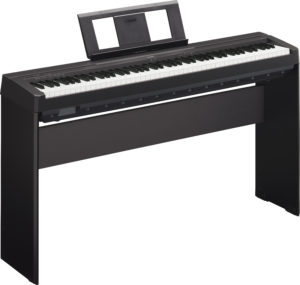
It has Duo to help you study with teacher, and Layer mode to combine and play two sounds simultaneously. In comparison with “plastic keyboards” which are described in the previous section, P45 and other Yamaha portable pianos doesn’t come with any built-in educational programs. However this piano is good to start practicing when you study with teacher or with the help of online piano lessons.
P-45 vs P-71
You may find very similar Yamaha portable digital pianos – P-45 and P-71. Actually there are no functional differences between them, you may buy any which is cheaper. P-71 is just another name for P-45 and is sold as Amazon exclusive model.
You can find this P45 (or P71) for the price below $400, so I recommend it to all my students who are on budget.
| Check Price on Amazon | Read Full Review |
P-125
P-125 is the latest middle-class Yamaha portable digital piano released in 2018. It came to replace the top selling P-115 and now is gaining popularity as the new Yamaha flagship. With the size and weight almost equal to P-45, it has much more options on-board: 24 sounds, 20 rhythms, improved 2-way speaker system which sounds much better than in P-45, more buttons for easier function change, but still simple and minimalistic design. Though it doesn’t have a screen on top panel, but there is a Smart Pianist App to control the device functions from your iPad. You can also use this app to learn to play chords from your favorite songs – Chord Tracker detects and shows them automatically.

P-125 has Drum&Bass tracks to accompany you and follow your harmony: feel yourself as if you are playing with a professional band!
Optional L-125 furniture style matching keyboard stand and LP-1 3-pedal unit will turn your portable P-125 into a very stylish interior piano.

I suppose that P-125 is the golden mean among Yamaha compact digital pianos. It can suit most musicians needs from beginners to professionals. Very recommended as very quality middle-class Yamaha portable piano.
| Check Price on Amazon | Read Full Review |
DGX-660
When I first sat in front of this instrument (I can’t call it a piano, it would not be fair) and tried “Ambient Piano” preset, I closed my eyes and was immediately convinced that this piano is real.
With the weight of more than 46 lbs (and more than 61 lbs with keyboard stand) DGX-660 can hardly be called portable and it also differs in many other things from the two P-series pianos I described above. But I decided to include it to my list, because many people choose between it and P-series. Actually DGX-660 took the very best of electronic keyboards from the first section of my article and portable digital piano from the second, and improved it many times.

DGX-660 is similar to Yamaha P-series in terms of GHS keyboard action type, 88 keys, very good piano sampled sounds. But it has an incredible number of additional very interesting features, including but not limited to:
- A lot more voices than other pianos have, including authentic guitar, strings, brass and more
- On-board Learning function
- Easy to read score and lyric display
- USB device input to connect your flash drive to record or playback music files in WAV format
- Smart Chord feature to create entire chords of any type you choose (from pop triads to complex jazz chords) just with a press of one finger in the left hand
- Aux Input to connect your external player (phone) and listen to the songs through DGX-660 speakers
- Microphone input: connect external microphone and sing along with your performance or with pre-recorded karaoke song files, view the lyrics on the score display
- Optional wireless adapter (UD-BT01) will connect the piano to your iOS device and allow to play songs from your device wirelessly through DGX-660 internal speakers
- … and much more.

The instrument comes with matching keyboard stand, and there are some options available to buy separately, such as LP-7A 3-pedal unit.
The only inconvenience I encountered at the beginning is that you will have to get used to the menu on the instrument, it is not intuitive and user-friendly at first glance.
Which is better – P-125 or DGX-660?
P-125 and DGX-660 can hardly be compared, because these are different class devices. P-125 is a light weight portable digital piano, and DGX-660 is an Instrument with lots of functions and features, including piano as only one of them. I can name only two reasons to prefer P-125 among DGX-660:
- P-125 is much lighter in weight and thus more portable
- P-125 is cheaper
And all the features of DGX-660 I listed above are its benefits. So if big weight is not a problem for you, I recommend you spend the extra few hundred dollars for this model. Even if you only play piano sound, you will sometimes want to have a little fun, and DGX-660 will surprise you with its fun way to enhance your experience!
| Check Price on Amazon | Read Full Review |
Best Yamaha Stage Digital Piano
This section could also be named “Best Yamaha Portable Piano above $1000“. Stage piano is a portable digital piano for live performances on stage or for recording on studio. It combines compact case, great quality piano sounds, rather big price (above $1000) and is used mostly by gigging musicians. But if you want to have a good portable instrument at home – stage piano can be your choice. Yamaha as a leading electronic keyboard manufacturer has several stage digital piano models, which I am going to describe below.
| P-255 | P-515 | CP40 | |
|---|---|---|---|
| Keyboard Action | Graded Hammer (GH) with Synthetic Ivory Tops | Natural Wood X (NWX) | Graded Hammer (GH) |
| Polyphony | 256 | 256 | 128 |
| Dimensions (WxHxD) | 52-1/2”x5-13/16”x13-13/16” | 52-5/8”x14-13/16”x5-11/16” | 52.4”x6.4”x13.8” |
| Dimensions (mm) | 1,333x148x351 | 1,336x145x376 | 1,332x163x352 |
| Weight | 38 lbs 2 oz | 48 lbs 8 oz | 36 lbs |
| Weight (kg) | 17.3 kg | 22.0 kg | 16.3 kg |
| Voices | 24 | 40 + 18 Drum/SFX Kits + 480 XG Voices | 297 |
| Rhythms | 10 | 40 | - |
| Preset Songs | 24 Voice Demo Songs, 50 Piano Preset Songs | 21 Voice Demo Songs, 50 Classics | - |
| User Songs | 10 (2 tracks) | 250 | - |
| Speakers | 2x10cm + 2x2.5 cm | 2x(12x6 cm) + 2x2.5 cm | - |
| Display | LED 7-segment | Full Dots LCD 128x64 | 40 characters x2 lines |
| Connections |
|
|
|
| Price | $$$ | $$$$ | $$$$$ |
| Rating |   (4.5 / 5) (4.5 / 5) |   (4.8 / 5) (4.8 / 5) |   (4.6 / 5) (4.6 / 5) |
P-255
P-255 is one step higher than the previous model in the line P-125. First of all it has better keyboard action – Graded Hammer with Synthetic Ivory tops, and I can say that the feel of the key amazed me. For even more realistic sound Yamaha integrated String Resonance feature: when the hammer of grand piano strikes the string, other string also resonate, P-255 can reproduce this effect. Besides piano it has many other top-quality voices, which you can mix in Layer mode.

P-255 is the first P-series instrument with 256-note polyphony, which allows you to perform any kind of music and not to worry about sounds cutting.
Minimalistic design and minimal number of buttons are one of P-series distinctive features. But this model also has LCD display, which helps you to navigate the functions easier.
The instrument has circular speakers which produce very clear and well-balanced tone. It seemed to me that the sound lacks bass frequencies on internal speakers. However if you turn on Sound Boost feature, you can get maximum of the sound. But anyway this is a stage piano, you will most likely connect it to external amplifier and it will sound without issues.

As an option you can buy L-255 matching stand and LP-255 three-pedal unit to convert your portable instrument into a very beautiful modern digital piano.
I recommend P-255 for professional musicians to play classical or may be jazz music, and for pianists who need to substitute acoustic piano while on tour.
| Check Price on Amazon |
P-515
P-255 has been a leader in Yamaha P-series for several years, until P-515 was developed and became a flagship Yamaha model. It features Natural Wood X keyboard, which is currently the top Yamaha Graded Hammer Action type. This keyboard together with enhanced Virtual Resonance Modeling (VRM) feature will give you the feeling of playing real acoustic top-class grand piano.

Besides that P-515 has onboard Bluetooth for seamlessly connecting your musical player to the internal speakers!
Of course USB-to-HOST and USB-to-DEVICE are also here to connect P-515 to computer or to connect USB flash drive for recording your performance.
I liked classical P-series modern design of P-515, and an optional L-515 matching stand with LP-1 three-pedal unit make it look perfect in the interior. Especially in white color, which I used to test.

P-515 is certainly top class Yamaha compact digital piano. At the time of review (Nov. 2018) it used to cost only $200 more than the previous model – P-255, so if you have a couple of hundred extra bucks you will not be disappointed investing it to the newest Yamaha instrument that will delight you for many years, at least until a new model comes up;)
| Check Price on Amazon |
CP40/CP4 and other CP-series
Actually CP40 and all CP-series are the only Stage pianos by Yamaha classification. Though I think that higher P-series instruments described above can be placed into this category also. It all depends on your needs. If you need ready-to-play piano for home training or for taking with you to play with the band occasionally – I would recommend P-515: it has easy controls, 256 polyphony voices, and great set of on-board rhythms to play with, internal speakers, ability to put it to a furniture-style stand and attach 3-pedal unit, and more.
CP40 is more serious model for stage or studio performances, it has a lot of sound and effects controls, it is capable of combining voices in many ways. If you are especially picky to the sound you can dive into the menu-driven programming system and see how flexible the sound is. CP40 keyboard can be used as four zone Master keyboard with programmable zones for MIDI channel, transposition, volume, pan, etc.
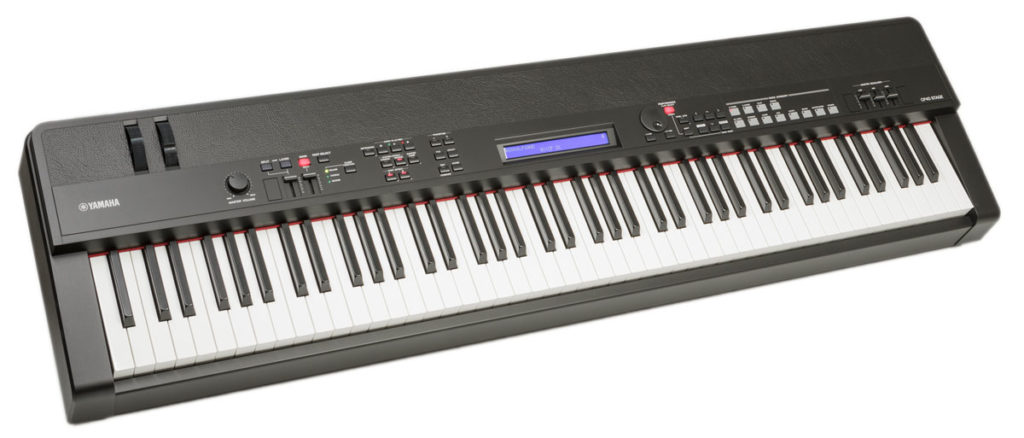
As per sound and keyboard – both CP-series a P-series have perfect piano sounds and keyboard action. For CP40 (the most affordable CP piano) it’s Graded Hammer Action (GH), like in P-255. And CP4 has Natural Wood keys – for the first time in CP lineup, like P-515 does. Note that Yamaha CP doesn’t have internal speakers, cause this is a professional instrument and is intended to be connected to external mixer or monitors.
I don’t want to go into details about CP series very much since this article is mostly for people choosing a piano for personal use. And I’m pretty sure that P-515 is the best Yamaha portable piano for most of you. But if you want to go deep into almost unlimited sound modification, than don’t miss CP40!
| Check CP40 Price on Amazon | Check CP4 Price on Amazon |
Best Yamaha Home Digital Piano
Of course you can buy any of the described Yamaha pianos and keyboards and use them at home. But when I’m saying “Home Digital Piano” I mean Yamaha console-style piano that fits your interior, looks stylish, sounds like a good acoustic wooden instrument, and doesn’t cost a fortune. Sounds too good to be true? This is because possibly you’ve never heard of Arius series. I will describe some of the top Yamaha Console Digital Pianos to help you make a correct choice.
| YDP-103 | YDP-143 | YDP-163 | YDP-181 | YDP-184 | |
|---|---|---|---|---|---|
| Hammer Action Type | GHS | GHS | GH3 (w/synth ivory tops) | GH | GH3 (w/synth ebony and ivory tops) |
| Polyphony | 64 | 192 | 192 | 128 | 256 |
| Weight | 82 lbs 11 oz | 83 lbs 12 oz | 92 lbs 10 oz | 110 lbs 4 oz | 123 lbs 7 oz |
| Weight (kg) | 37.5 kg | 38.0 kg | 42.0 kg | 50.0 kg | 56 |
| Dimensions (WxHxD) | 53-7/16”x32-1/16”x16-5/8” | 53-7/16”x32-1/16”x16-5/8” | 53-7/16”x33-27/64"x16-5/8" | 53-11/16"x33-9/16"x20-1/4" | 57-1/2"x36-1/2"x18-1/16" |
| Dimensions (WxHxD), mm | 1,357x815x422 | 1,357x815x422 | 1,357x849x422 | 1,364x853x515 | 1,461x927x459 |
| Voices | 10 | 10 | 10 | 14 | 24 |
| Rhythms/Accompaniment styles | - | - | - | - | 20 |
| Preset Songs | 10 demo songs, 10 piano songs | 10 demo songs, 50 piano songs | 10 demo songs, 50 piano songs | 14 demo songs, 50 piano songs | 14 demo, 50 piano |
| User Songs | - | 1 | 1 (2 tracks) | 3 (2 tracks) | 250 (16 tracks) |
| Tone generation | AWM Stereo Sampling | Pure CF Sound | Pure CF Sound | AWM Stereo Sampling | CFX Sampling |
| Speakers | 2x(Oval 12x6cm) | 2x(Oval 12x6cm) 2x10W amplifier | 2x(Oval 12x6cm) 2x20W amplifier | 2x16 cm 2x20W amplifier | 2x16 cm 2x30W amplifier |
| Display | - | - | - | LED (7-segment/3 digit) | Full Dots LCD 128x64 |
| Connections |
|
|
|
|
|
| MIDI connectivity | - | - | - | In/Out | In/Out/Through |
| Yamaha Portable Analog | P-45 | P-125 | P-255 | P-255 | P-515 |
| Colors | Dark Rosewood | Dark Rosewood, Black Walnut | Dark Rosewood, Black Walnut | Dark Rosewood | Dark Rosewood |
| Price | $ | $$ | $$$ | $$$ | $$$$ |
| Rating |   (4.1 / 5) (4.1 / 5) |   (4.3 / 5) (4.3 / 5) |   (4.5 / 5) (4.5 / 5) |   (4 / 5) (4 / 5) |   (4.6 / 5) (4.6 / 5) |
YDP-103
YDP-103 is very similar to P-45 portable piano placed into a wooden cabinet with 3 pedals and more powerful acoustics. Actually the case is not wooden, but it has wood grain finish, which doesn’t look cheap at all. As all Yamaha pianos, YDP-103 is built with quality.

The instrument has everything a novice piano player needs: 88 Graded Hammer Standard keys with 3 touch response levels, 2 realistic grand piano voice as well as E. Piano, Organ, Harpsichord and Vibraphone, Layer/Dual/Duo mode, metronome, transpose, two headphones outputs and 20 pre-recorded songs. Also you have the ability to connect YDP-103 to your computer by USB printer-style cable and record your performance. By using (separately sold) Yamaha UD-BT01 or Lightning-USB Camera Adapter, you can connect iOS device and use YDP-103 as a controller or sound source for many music creation applications.
Though YDP-103 interface is very simple – it has only a couple of buttons to control everything, but you can use Digital Piano Controller app on your iPad and access features more quickly and in a more interactive way.
I should note that some novice players can feel lack of Lesson mode in Arius pianos which helps you to learn music step by step. But if you study with a teacher and want to have a good stylish instrument to start with, YDP-103 is a nice choice for the money. At the time of review it could be found on Amazon for less than $900 including bench. If you have extra $150-200 to spend, I recommend checking the upper Arius model.
| Check Price on Amazon |
YDP-143
YDP-143 is one step higher than the younger Yamaha Arius model YDP-103. It has 192 polyphony voices and sounds more natural because of the progressive tone generation engine called Pure CF. Keyboard action is Graded Hammer Standard, which is good for beginners. Maybe some professional pianists will find it a little unnatural, but this is a matter of taste and habit. As for me – I like GHS action and can recommend it as not very expensive but quality option for budget buyers.

YDP-143 has 3 piano voices, 2 electric pianos, 2 organs, harpsichord, vibraphone and strings. All of the sounds are of decent quality, besides you can add 4 types of reverb effects to them, each with regulated depth.
The stored songs on YDP-143 are of different difficulty from very easy to intermediate, and all of them are in the included music book.
All the YDP-143 features can be switched with the buttons on the piano panel. But you can control them more easily by using the Controller App for iOS which provides graphical interface for all the features.
I managed to be at my friends place when his ordered YDP-143 was delivered. I was impressed how well the instrument was packaged – minimum wasted space, no parts can be scratched at the time of transfer or when unpacking. And the box feels like one solid piece. It’s good that there were two of us to assemble it. Though it is not very heavy, but if you order it for a child, don’t expect him to unpack and put it in place alone without adult’s help. The version which I saw was Dark Rosewood and I can say for sure that when assembled YDP-143 looks as if it costs much more than it does.
So I can recommend YDP-143 as a classic standard for Home digital piano, which looks great in the interior and has all the features you need to practice.
| Check Price on Amazon |
Yamaha YDP-143 and P-125 (P-115)
Every Yamaha Arius digital piano has its’ corresponding portable P-series model. For YDP-143 this is P-125 (or P-115 of the previous generation). These two pianos are very close by feature set; the main difference is in design and portability. Other parameters are listed in the table below.
Notice that 3-pedal unit is built into YDP-143 console-style cabinet and you will have to buy keyboard stand and pedal unit separately for P-125.
To summarize, P-125 is ideal for those musicians who don’t have much space for static console digital piano at home, or need to take piano out on gigs. And YDP-143 being very similar by features looks perfect in the interior. Also portable piano is cheaper, but don’t forget about additional expenses for piano stand and pedal unit if you need one.
YDP-163
YDP-163 piano is more expensive than the previous YDP-143 model, but actually these two models are very similar. The main difference which you are paying for is the keyboard action. YDP-143 has the most budget Yamaha’s Graded Hammer Standard (GHS) and YDP-163 has improved Graded Hammer 3 (GH3) with synthetic ivory key tops. As I talked about different Yamaha keyboard actions earlier, I will be short here: GH3 has 3 sensors for more natural grand-piano response (vs 2 sensors in GHS). The feeling of keyboard response is very subjective and there is no single standard for it. A beginner piano player will hardly notice any difference and will be ok with any keyboard action – GHS or GH3. Professional pianists should try to play both and choose which they like more. I prefer GH3, just because I got used to it.

Though YDP-163 and YDP-143 has the same size speakers, but the amp power for YDP-163 provides two times more power – 40 W vs 20 W in YDP-143. You will hardly notice this difference in real life, because 20 W is more than enough for medium-sized room, I believe you will never set the volume to more than 3/4 of maximum value.
So what is my opinion about Yamaha YDP-163? This is a great Home digital piano with advanced GH3 3-sensor keyboard action. The piano fits any interior (you can choose between two colors: Dark Rosewood, Black Walnut). The included piano bench is also a nice pleasantness. YDP-163 will be good for both the beginners and professionals, but the latter should try the keyboard first before buying.
| Check Price on Amazon |
YDP-181
This is classical Yamaha Arius piano, it has been developed long ago and still does not come off the assembly line, but I think it will be discontinued soon. Being rather old, you may find the YDP-181 characteristics are a bit outdated compared to other Arius models, though they are still good in 2019. YDP-181 has 128 polyphony notes, 14 voices, and simple 3-digit LED display. The keyboard action is Graded Hammer (GH), which is one step higher than Graded Hammer Standard by Yamaha classification. 2 big internal speakers allow bass tones to sound very powerful and 2 phone connections as on other Arius models allow to practice in silence together with your teacher or partner so that only two of you hear what you play.
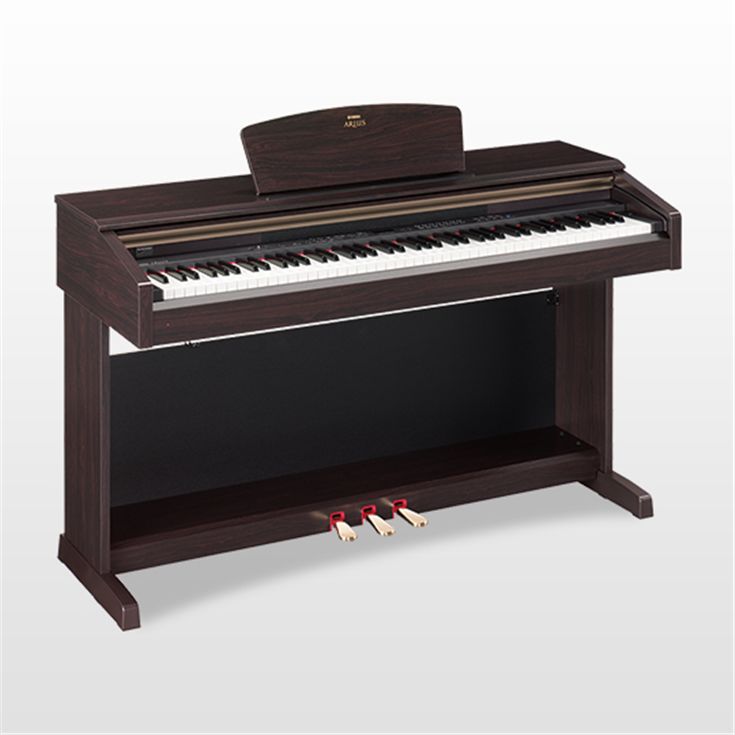
Though very simple, the LED display in the center helps you to control voices and functions of YDP-181 more easily. Generally there are a lot more buttons on top panel of this piano, then on younger Arius models. Some users like it, but personally I prefer small control panel to the left of the keyboard is more convenient to use.
Instead of USB-to-DEVICE, this piano features old-fashioned MIDI in/out connectors.
Actually I think that there is no much sense buying YDP-181 now, especially after less expensive and more modern model YDP-163 is out. If you have some free money, you can even go upper for the latest YDP-184.
| Check Price on Amazon |
YDP-184
Announced in 2018 YDP-184 is the newest top-line Arius piano, therefore it features all the best in sound technology. To create the most realistic piano sound including the nuances coming from wooden grand piano body, string resonance, tonal overtones and so on, Yamaha combined acoustic sampling with computer modeling and created the most realistic and expressive piano sound that you can get. Yamaha used popular Clavinova model CLP-635 to create this budget clone of it by removing some features. These models have the same cabinet design, but YDP-184 is available only in Rosewood color (CLP-635 is in Black color also).

One can hardly call YDP-184 a budget model, because it costs more than $2000. This is actually the most expensive Arius digital piano. But if you liked Clavinova pianos and want to save money, this piano is for you. For the money you get:
- GH3 keyboard action
- 24 voices (including main Yamaha CFX grand and 3 other acoustic piano voices, harpsichord, strings, E-pianos, choirs, organs, etc. – plenty of voices to play with)
- 256 polyphony
- USB-to-HOST (to connect to computer or iPad for recording MIDI or using educational software)
- traditional MIDI IN/OUT/THROUGH
- USB-to-DEVICE (to save your songs to flash drives)
- 20 rhythms (this is the only Arius piano which have built-in drum patterns to play along giving you an experience playing various styles with a real drummer)
- AUX IN and OUT (to connect to external amplifiers)

YDP-184 has compact control panel with LCD screen located to the left of the keyboard. I like that minimalistic style controls opposed to many buttons all over the keyboard like in YDP-181.
Another great feature is the recording function. It allows you to use internal midi sequencer to record up to 250 songs each with 16 tracks. You can also record you performance as WAV file.
The speakers of YDP-184 are big and powerful, you get 60 Watts of sound, which is enough for home use and even for small church or even concert hall. Though I prefer when digital piano speakers has twitters, this 2×16 cm speakers are ok and sound pretty good even on high tones.
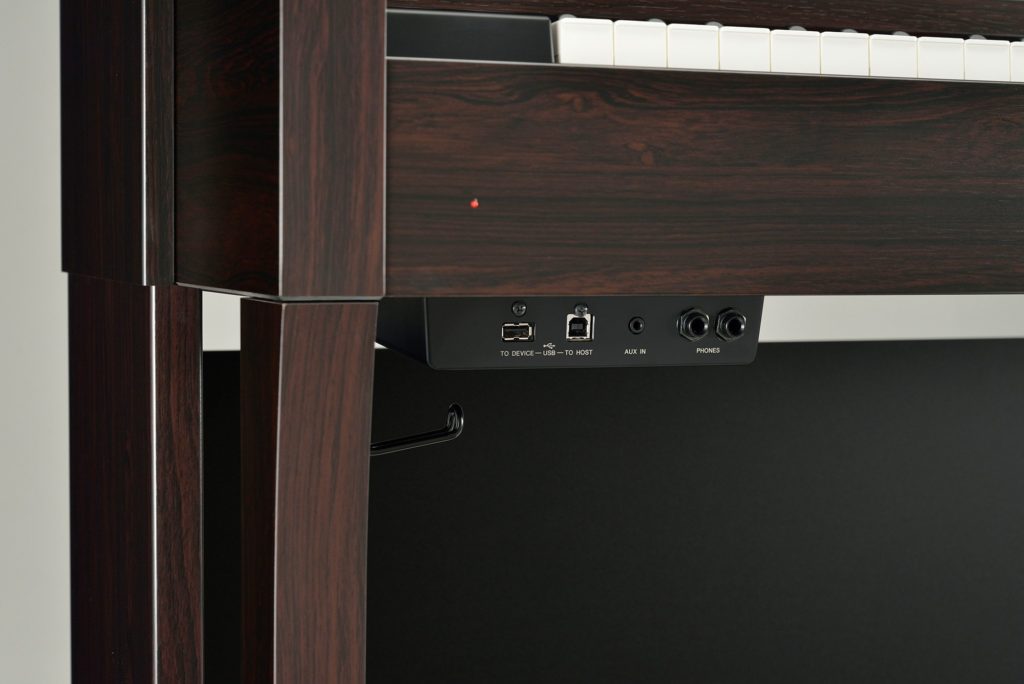
The piano is very heavy, so don’t try to lift it up yourself.
I recommend YDP-184 as an ideal Yamaha Home Digital piano for both beginners and professionals if your budget is around $2000-$2200 and you want something top for that money. The next level up and $1000 more is Clavinova series, but this is a topic for a separate article.
| Check Price on Amazon |
YDP-184 vs CLP-645 vs P-515
Yamaha Arius YDP-184 and Clavinova CLP-645 are beautiful and stylish Yamaha digital pianos for home use. You may wonder why Yamaha portable piano P-515 is here? We’ll see.

If you are choosing between them then you are probably looking for a perfect Yamaha digital piano. As per 2019 YDP-184 and P-515 are top level devices in their categories. CLP-645 is middle class Clavinova piano, but is very feature rich and high tech. So all these pianos can be compared. The cheapest device among them is P-515, but does it mean that it is worse than the others? Let’s look at YDP-184, CLP-645 and P-515 specs comparison table to see the differences graphically.
| YDP-184 | CLP-645 | P-515 | |
|---|---|---|---|
| Photo | 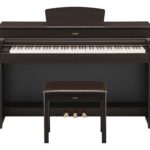 | 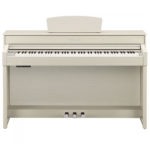 | 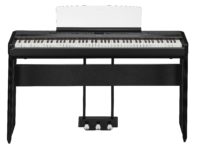 |
| Polyphony | 256 | 256 | 256 |
| Keyboard | GH3 (w/synth ebony and ivory tops) | Natural Wood X (NWX): wooden keys (white only), synth ebony and ivory tops, escapement | Natural Wood X (NWX): wooden keys (white only), synth ebony and ivory tops, escapement |
| Tone Generation | CFX Sampling | Yamaha CFX, Bösendorfer Imperial, CFX Binaural Sampling | Yamaha CFX, Bösendorfer Imperial, CFX Binaural Sampling |
| Voices | 24 | 36 | 40 + 18 Drum/SFX Kits + 480 XG Voices |
| Rhythms | 20 | 20 | 40 |
| Songs (voice+piano) | 14 voice + 50 piano | 19 voice + 50 piano + 303 lesson songs | 21 voice + 50 piano |
| User Songs | 250 (16 tracks) | 250 (16 tracks) | 250 |
| Midi Connectivity | In/Out/Through | In/Out/Through | In/Out |
| Speakers | 2x16 cm 2x30W amplifier | 2x(16cm + 8cm) 2x(25W + 25W) amplifier | 2x(12x6 cm) + 2x2.5 cm 2x(15W + 5W) amplifier |
| Display | Full Dots LCD 128x64 | Full Dots LCD 128x64 | Full Dots LCD 128x64 |
| Connections |
|
|
|
| Key Cover | Sliding | Sliding | - |
| Weight | 123 lbs 7 oz | 132 lb, 4 oz (Polished finished: 145 lb, 8 oz) | 48 lbs 8 oz |
| Weight (kg) | 56 kg | 60 kg (Polished finisehd: 66 kg) | 22.0 kg |
| Price | $$$ | $$$$ | $$ |
| Editors Rating |   (4.5 / 5) (4.5 / 5) |   (4.7 / 5) (4.7 / 5) |   (4.8 / 5) (4.8 / 5) |
You may notice that despite the price CLP-645 (about $3500) and P-515 (about $1500) are rather similar by many characteristics, such as
- Keyboard action (NWX)
- Tone generation (Yamaha CFX, Bösendorfer Imperial, CFX Binaural Sampling)
- Connectivity
By some of them P-515 is even better:
- Number of voices and rhythms
- Weight and portability
So I can say that CLP-645 and P-515 are rather similar products, the main difference is portability and design. Clavinova is designed to stay statically in your room, and looks sturdy and stylish. P-515 is light-weight and portable, but furniture-style stand gives it all it needs to fit into interior. And if necessary it can be easily disconnected from the stand and taken away on a gig or some performance. As per me this gives P-515 a big advantage.
YDP-184 (for about $2000) is a bit behind the leaders (by characteristics) with GH3 keyboard (though high class also, but without escapement and wooden keys) and with a simpler acoustic system of only two speakers instead of four.
P-515 looks more simple then CLP and YDP, and doesn’t have sliding cover, but the feature set, feeling of keys and the sound of P-515 covers the exterior flaws. Don’t get me wrong, P-515 looks great, but CLP and YDP are specially designed to look like classical upright pianos, and P-515 was primarily designed for portability.
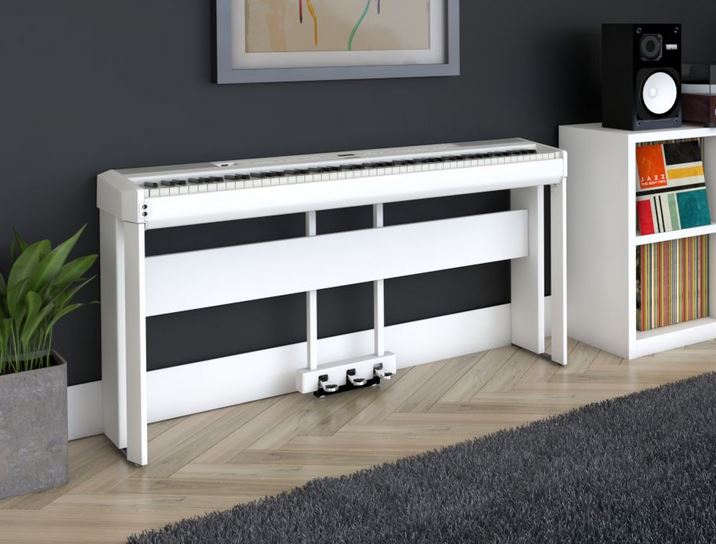
If I were choosing among these three instruments, I would prefer P-515. Though the cost of furniture style stand and pedal unit will add a couple of hundred dollars to it’s price, but anyway it will be much cheaper then Clavinova or even Arius. And buying it you get high end Yamaha NWX keyboard action, quality built-in acoustics, and portability which none of the other two pianos has. If your budget is unlimited and you don’t need to move the piano very often, then go for Clavinova CLP-645. And if you prefer to save some money but want a stylish home piano, then you should choose YDP-184 – top level Yamaha Piano in the Arius product line.
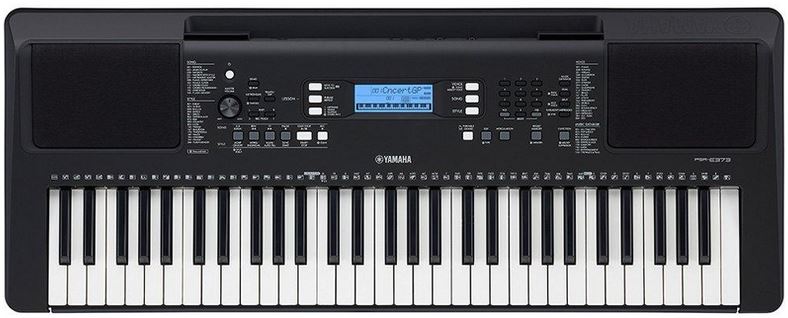
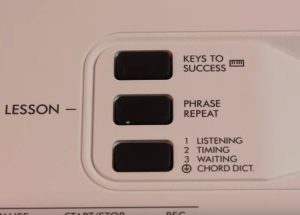
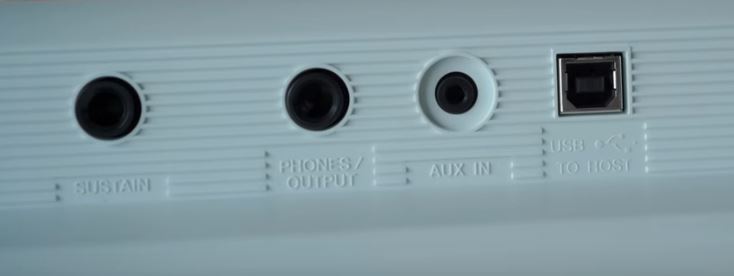
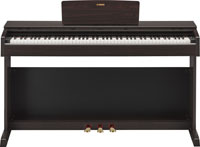
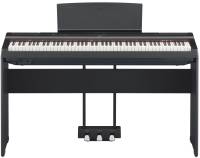
I’ve owned a white Yamaha P-515 with the 3-pedals and furniture stand for almost 2 years and love every moment I play it! I think it takes ‘portable’ digital pianos to another level. I previously owned a Yamaha S-90, which I loved the sound, but prefer the Yamaha P-515’s piano experience and sound! Yamaha has produced a great instrument in the P-515!
Just got my hands on the Yamaha PSR-E473 and I’m blown away! The sound quality is superb, the keys feel great, and the range of voices and effects is impressive. It’s packed with features and has reignited my passion for playing. Best investment for any aspiring musician! Thanks for review!
Hello I wanted to buy a Yamaha PDP 100. But I cant find any reviews about it. What is your opinion about this digital piano.